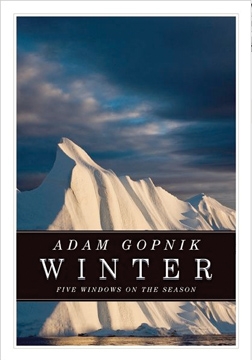Winter: Five Windows on the Season, by Adam Gopnik • Anansi Press, 2011, 256 pgs.
Some of the finest days occur in the month of October. Warm, golden days are typically followed by cool nights. Green landscapes are transformed into beautiful combinations of red, orange and yellow. But the beauty of fall brings with it the promise of an infinitely more challenging season, winter. Not long after the leaves have fallen and the trees are bare, much of Canada will be contending with winter’s deep freeze. The further north, the more bitter the cold, the shorter the days and longer the nights. Another flu season will render many sick and listless and longing for the warmth of summer. Yet for all of winter’s challenges, there will be compensatory pleasures. The hockey season will be in full swing. As we move into the heart of the season, kids will not only play the game in indoor rinks, but on frozen ponds under clear skies. Others will find joy in skiing down a snow-covered mountain or across snow-filled trails. Families flock to the Rideau Canal, stopping their skate only to line up for a hot chocolate or a beaver tail.
As Adam Gopnik’s book Winter (and this year’s CBC/Massey Lectures) makes clear, winter is at once a season of struggle and joy. Yes winter is a period of sustained darkness and biting cold. But for Gopnik, who was born in Philadelphia but raised in Montreal, few images resonate more strongly than of kids playing hockey on frozen ponds as dusk falls on a cold December day or of scenes of families huddling by the fire, while frost builds on the windows. The images are familiar but call to mind separate pleasures. There is the experience of winter outdoors – playing hockey on the outdoor rink or trudging through the snow – and the joy of warmth when outside is freezing and streets are covered in ice. We relish both kinds of winter experience.
But if this were all Gopnik celebrates, the choice of winter as the theme of this year’s CBC/Massey Lectures would have been odd. Indeed, Gopnik’s aim in part is to delve more deeply into our experience and understanding of the coldest season. In doing so, he moves back and forth through time and examines winter through the lens of poets, painters, novelists and musicians. Many of the ideas and images we associate with the season are familiar, even to those who don’t live in a cold climate. Others are not obvious at all and it is these that give the book a depth and intellectual heftiness that we expect from a writer of Gopnik’s calibre. He writes, for example, of winter’s connection to German art and the country’s nationalist ambitions in the 18th century. Embracing winter’s severity, we are told, was part of Germany’s response to the exaggerated promise of the Enlightenment emanating from France.
Moreover, our experience of winter is perpetually changing, sometimes subtly but occasionally in a truly profound manner. The combination of urbanization and technological change has allowed more of us to remain removed from the cold. As Gopnik explains, Montreal is increasingly comprised of two cities, one above ground and the other subterranean. People can walk nearly twenty miles underground, access hundreds of shops and most of the city’s business area and the Metro without having to walk outside. As much as we may love winter, in big cities especially, we are constantly and often ingeniously searching for ways to experience it from a position of warmth and comfort. Such efforts are understandable but still may leave us nostalgic for a time in which winter was more deeply experienced and fully embraced.
Indeed the connection between memory and winter is a theme that winds its way through the entire book. Occasionally, the insights this connection yields strike the reader as arbitrary or forced. Is winter really, as Gopnik contends, the season we most readily associate with memory? Nevertheless, that connection seems strikingly prescient in the book’s final chapter, in which Gopnik discusses the growing threat of global warming. Winter, he suggests, is a season from which we often attempt to escape. But for many of those that find refuge in the south, the memory of winter often reveals an unexpected attachment to the season. Gopnik occasionally refers to Joni Mitchell’s classic song “River,” in which she sings in a voice rich with longing and melancholy. “I wish I had a river that I could skate away on.” As the planet warms, winter will increasingly become the season for which we long. To be sure, it’s premature to speak of winter’s disappearance, but hardly premature at all to insist anthropogenic-induced climate change threatens winter as we know it now. Glaciers are melting, the ozone layer above the Arctic Circle is disappearing and winter temperatures are gradually inching their way higher. No one knows for certain the long-term implications of unsustainably high green house gas emissions, particularly for a country as big and geographically varied as Canada. But by anticipating the potentially dire consequences of global warming, Gopnik’s ode to winter is, by the book’s end, a beautiful lament for that which is slowly being lost.

